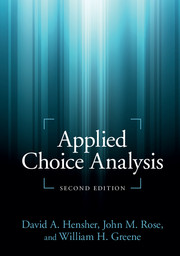Book contents
- Frontmatter
- Contents
- List of Figures
- List of Tables
- Preface
- Part I Getting started
- Part II Software and data
- Part III The suite of choice models
- 11 Getting started modeling: the workhorse – multinomial logit
- 12 Handling unlabeled discrete choice data
- 13 Getting more from your model
- 14 Nested logit estimation
- 15 Mixed logit estimation
- 16 Latent class models
- 17 Binary choice models
- 18 Ordered choices
- 19 Combining sources of data
- Part IV Advanced topics
- Select glossary
- References
- Index
15 - Mixed logit estimation
from Part III - The suite of choice models
Published online by Cambridge University Press: 05 June 2015
- Frontmatter
- Contents
- List of Figures
- List of Tables
- Preface
- Part I Getting started
- Part II Software and data
- Part III The suite of choice models
- 11 Getting started modeling: the workhorse – multinomial logit
- 12 Handling unlabeled discrete choice data
- 13 Getting more from your model
- 14 Nested logit estimation
- 15 Mixed logit estimation
- 16 Latent class models
- 17 Binary choice models
- 18 Ordered choices
- 19 Combining sources of data
- Part IV Advanced topics
- Select glossary
- References
- Index
Summary
The secret of greatness is simple: do better work than any other man in your field – and keep on doing it.
(Wilfred A. Peterson)Introduction
The choice modeler has available a number of econometric models. Traditionally, the more common models applied to choice data are the multinomial logit (MNL) and nested logit (NL) models. Increasingly, however, choice modelers are estimating the mixed logit (ML) or random parameters logit model. In Chapter 4, we outlined the theory behind this class of models. In this chapter we estimate a range of ML models using Nlogit, including recent developments in scaled mixed logit (or generalized mixed logit). As with Chapters 11 and 13 (MNL model) and Chapter 14 (NL model), we explain in detail the commands necessary to estimate ML models as well as the interpretation of the output generated by Nlogit. An understanding of the theory behind the ML model is presented in Chapter 4; however we anticipate that in reading this chapter you will have a better understanding of the model, at least from an empirical standpoint.
The mixed logit model basic commands
The ML model syntax commands build on the commands of the MNL model discussed in Chapter 11. We begin with the basic ML syntax command, building upon this in later sections as we add to the complexity of the ML model.
- Type
- Chapter
- Information
- Applied Choice Analysis , pp. 601 - 705Publisher: Cambridge University PressPrint publication year: 2015



